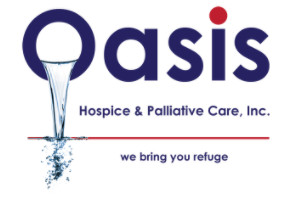In Home Hospice Care in Crete
in home hospice care Crete Serving Cook, Will & DuPage Counties in Illinois
Hospice Crete
OASIS MISSION STATEMENT
Oasis Hospice & Palliative Care, Inc. believes in affirming life. We exist to be a sanctuary and a refuge for our patients and their families thereby improving the quality of life for our patients who are dealing with life-limiting illnesses.
What is Hospice?
The video below will give you a better idea on what hospice actually is, why would you need it, when do you need it, and how to reach us.
About Oasis


Our Testimonies
in home hospice care
When a patient is at first referred to hospice care, typically by their physician or a caseworker within the health center, they are usually offered a list of hospice companies in their area to select from. Sometimes these referral sources have a specific agency that they choose and their recommendations should not be taken gently; they are in the position to see how well a particular firm looks after their patients. However, as with any healthcare decision, you should be as notified as possible in order to know that you are making the very best decision for you and your liked ones. LWA/ Getty Images All hospice firms work within the standards set forth by Medicare.
This might leave you wondering why it would even matter which hospice agency you choose. There are differences, however, and they’re frequently hidden in the small details. It is very important to do a little research study from the start to find where those differences lie. Your very first interaction with a hospice company might occur over the phone after they get your recommendation info and call you to establish a visit. It might take place in the health center setting when an agent from the firm pertains to assess your loved one and offer details. It might be started by you. Regardless of how your preliminary interaction occurs, there are some important realities to gather from the start.
Really couple of hospices have inpatient centers, which suggests that the majority of people receive hospice care through an independent firm. So, probably the most essential question you can ask a hospice center is associated with the area of their nurses. Just to clarify, it truly makes no distinction where the company’s workplace lies, however it makes a big distinction where the nurses are located. I used to work on-call for a big hospice agency that covered 3 counties, over 200 square miles. On weekends, I covered the whole area with just the help of one LVN (certified professional nurse). Subsequently, I would sometimes be with a patient in one county and get a call from another client who had a crisis in another county who then had to wait two hours or more till I had the ability to arrive.


Keep in mind that some hospice companies have numerous branch workplaces that could be 50 miles or more apart from each other. Make sure that if the agency your taking a look at has multiple branch offices that they also have a separate on-call nurse covering each one which the on-call nurse covering your area also lives in your location. If you have a crisis in the middle of the night or on the weekend, the last thing you wish to do is wait 2 or more hours for assistance.
There may be one hospice company, or several that serve your neighborhood. It is essential to find out about the services that each hospice uses. If there are numerous hospices that serve your area, you might wish to demand services from a specific hospice and can communicate that wish to your physician. Are all hospices the very same? How do I decide if hospice is the suitable care option for me? How do I pick among different hospice programs? If there is only one hospice program in my community, how do I determine if it is an excellent one? These prevail questions for people and loved ones facing life-limiting health problems.
Crete (Greek: Κρήτη, Modern: Kríti, Ancient: Krḗtē, [krέːtεː]) is the largest and most populous of the Greek islands, the 88th largest island in the world and the fifth largest island in the Mediterranean Sea, after Sicily, Sardinia, Cyprus and Corsica. It bounds the southern border of the Aegean Sea. Crete rests approximately 160 km (99 mi) south of the Greek mainland. It has an area of 8,336 km2 (3,219 sq mi) and a coastline of 1,046 km (650 mi).
Crete and a number of islands and islets that surround it constitute the Region of Crete (Greek: Περιφέρεια Κρήτης), which is the southernmost of the 13 top-level administrative units of Greece, and the fifth most populous of Greece’s regions. Its capital and largest city is Heraklion, located on the north shore of the island. As of 2011, the region had a population of 623,065. The Dodecanese are located to the northeast of Crete, while the Cyclades are situated to the north, separated by the Sea of Crete. The Peloponnese is to the region’s northwest.
Humans have inhabited the island since at least 130,000 years ago, during the Paleolithic age. Crete was the centre of Europe’s first advanced civilization, the Minoans, from 2700 to 1420 BC. The Minoan civilization was overrun by the Mycenaean civilization from mainland Greece. Crete was later ruled by Rome, then successively by the Byzantine Empire, Andalusian Arabs, the Venetian Republic, and the Ottoman Empire. In 1898 Crete, whose people had for some time wanted to join the Greek state, achieved independence from the Ottomans, formally becoming the Cretan State. Crete became part of Greece in December 1913.
The island is mostly mountainous, and its character is defined by a high mountain range crossing from west to east. It includes Crete’s highest point, Mount Ida, and the range of the White Mountains (Lefka Ori) with 30 summits above 2000 metres in altitude and the Samaria Gorge, a World Biosphere Reserve. Crete forms a significant part of the economy and cultural heritage of Greece, while retaining its own local cultural traits (such as its own poetry and music). The Nikos Kazantzakis airport at Heraklion and the Daskalogiannis airport at Chania serve international travelers. The palace of Knossos, a Bronze Age settlement and ancient Minoan city, is also located in Heraklion.
[adm-seo-meister-related-links output_type=”list_links” link_title=”%title” limit=”5″ columns=”1″ parent_title=”%title” next_title=”%title »” prev_title=”« %title” post_status=”publish” orderby=”none” order=”asc”]

